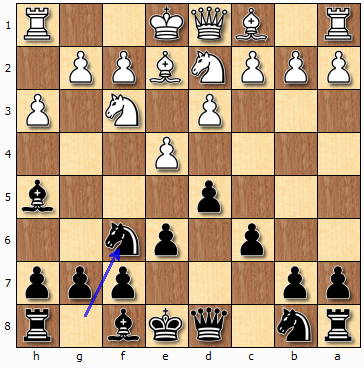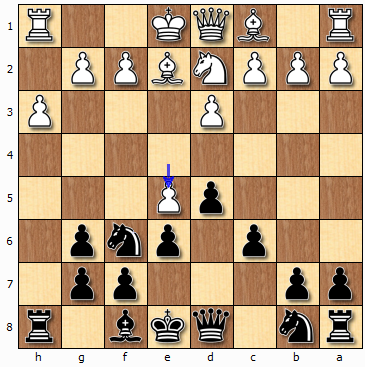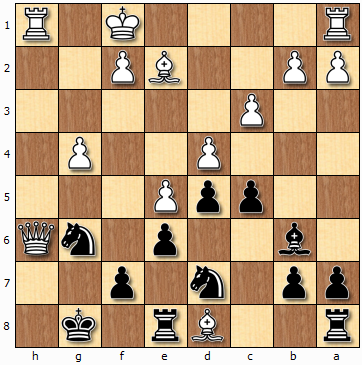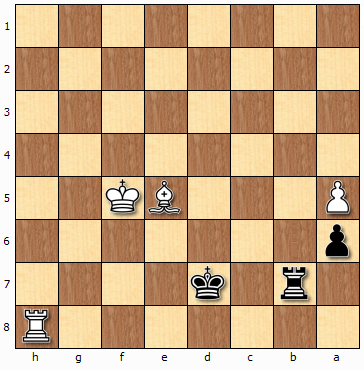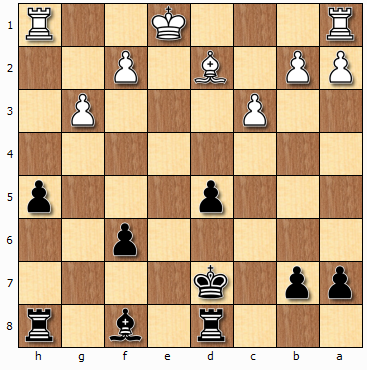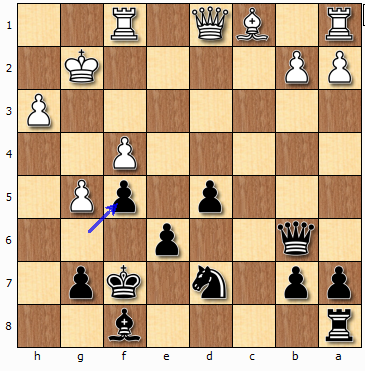16:03 The Caro-Kann defense with 2. Nf3, Part 2 |
|
In the previous parts we considered the variations with 3. ed. This part begins studying the variations when White decides to defense the e pawn attacked by Black’s d pawn in the second move. Firstly, we investigate the variations where White defenses the e pawn with its d pawn by moving 3. d3. In this case, one of the most reliable opening’s version is the following: 1. e4 c6
Now it’s strong for White to move 7. N e5. After 7. N e5, Black has the two choices – either to exchange the white - square bishops or to move the bishop to the g6 square. According to my analysis, 7. … B g6 is bad option for Black. Why it’s like that is a big and difficult subject. This question may cover the several parts. I’d like to consider this question first of all. When done we proceed to the consideration of the “7. N e5” move to understand its idea. So, let us focus on the question what’s wrang to the “7. … B g6” move. The game continues: 7. N e5 B g6 Now White and Black do their best and play: 8. N x g6 hg
Now the two strongest moves for Black are 9. … N g8 and 9. … Nd7. According my analysis, both of these moves may hold a drawish position, but Black should be incredible accurate for that one. I’d like to justify these conclusions. Let us start with the “N g8” move: 9. … N g8 Now we check if Black is able not to lose if Black makes a short castling or a long castling. Firstly we consider the variations with a long castling. It seems the following variation is not bad for Black to do a long castling: 10. c3 N h6
However, Black loses in this case. I will build my justification as follows. Firstly, I will present the main line of this variation. This presentation will show us that if the game follows the main line then Black loses. Then, I will justify that Black has no better variation – in all other branches of the main line Black loses too. So, go ahead. The main line is the following: 14. B f4 B e7 15. B d3 K b8 16. K f1 c5 17. K g2 R c8 18. B d2 N f5 19. h4 K a8 20. R e1 Q d8 21. R b1 Q b6 22. a4 Qc7 23. b3 a5 24. B b5 cd 25. cd N b8 26. Q e2 B a3 27. R ed1 B b4 28. R dc1 Q e7 29. B g5 f6 30. R x c8 R x c8 31.R c1 R h8 32. B f4 g5 33. hg fg 34. B x g5 Q f7 35. R h1 R x h1 36. K x h1 Q h5 + 37. K g2 Q g4 38. B f4 N c6 39. Q d3 Q g6 40.B g5 K b8 41. g4 N c x d4 42. gf N x f5 43. Kf1 Q h5 44. B d7 Q h3 + 45. K e2 Q g2 46. K d1 Q h1 + 47. Ke2 =>
We see White has an extra bishop and a winning position. Thus we, saw the main line leads to White’s victory. Let’s make sure that Black can't hope for anything better. First fail from the end in the main line is that Black loses the knight pinned with the queen after 41. g4. Let us assume Black avoids this pinning playing: 39. … Q h5. If so the game may continue: 40. B x c6 bc 41. Q a6 + K b8 42. Q b6 + K c8 43. Q x c6 + K b8 44. Q b6 + K a8 45. N g5 and White gets the absolutely winning position: =>
Therefore, the “39. … Q g6” move is necessary to prevent this one. Let us assume Black play other way to prevent pinning. Say, Black plays 38. … Q g6 planning to put the queen to the f7 square. If so the game may continue: 39. B g5 Q f7 40. Q c2 K a7 41. Q c8 N e7 42. Q c7 Q f8 43. B x e7 Q x e7 44. Q x e7 B x e7 45. B e8 N c6 46. K h3 N b4 47. K g4 B d8 48. K h5 N d3 49. K g6 N x f2 50. K x g7 K b8 51. K f7 B b6 52. K x e6 K c7 53. K x d5 K d8 and White gets the absolutely winning endgame: =>
Let us assume Black puts the queen to the f7 square still earlier, say, in the 37 – th move. If so the game may continue: 37. ... Q f7 38. Q c2 N e7 39. Q c7 Q f8 40. B x e7 Q x e7 (if 40. ... B x e7 then 41. Q x a5+ N a6 42. B x a6 ba 43. Q x a6+ and White wins) 41. Q x e7 B x e7 42. K h3 N c6 43. B x c6 bc 44. K g4 c5 45. dc B x c5 46. N g5 B x f2 47. N x e6 d4 (if 47. ... K b7 then 8. N x g7 K c7 49. N e6 + K c6 50. N f4 d4 51. K f3 B e3 52. K e4 K c5 53. N d3 + K b6 54. N f4 K c5 55. Ne6 + Kb4 56. N x d4 Bc1 57. g4 Bg5 58. Kf5 Bd2 59. e6 Kc5 60. e7 and White wins again) 48. K f3 B e1 49. N x d4 and White gets the winning endgame: =>
Let us assume Black refuses moving the queen to the king side and plays 36. … Q c7 to prevent the invasion of White’s queen in the queen side. If so the game may continue: 37. K g2 Q c3 38. Q d1 N c6 39. B d2 Q b2 40. B c1 Q c3 41. B d2 Q b2 42. B x c6 bc 43. Q c1 Q x c1 44. B x c1 B c3 45. B e3 c5 46. dc d4 47. B f4 d3 48. c6 K b8 49. B d2 B x d2 50. N x d2 N d4 51. g4 K c7 52. f4 g6 53. K f2 K x c6 54. K e3 K c5 55. N e4 + K d5 56. Nd 2 K c5 57. K x d3 K d5 58. g5 N c6 59. N c4 K c5 60. N d6 K d5 61. N b5 N b4 + 62. K e3 N a6 63. N d4 N b4 64. N b5 N c2+ 65. K f3 N e1 + 66. K g4 N c2 67. K f3 K c6 68. K e4 N b4 69. K d4 K b6 70. K c3 N d5 + 71. K c4 N x f4 72. N d4 K b7 73. K c5 K c7 74. K b5 K d7 75. K x a5 N d3 and White wins in the endgame again: =>
Definitely Black gets anything wrang. So, Black should change the course of the game at an earlier stage. To do this Black may try to continue the game without rocks playing 31. … R x c1. If so the game may continue: 32. B x c1 Q c7 33. B f4 Q c8 34. B d2 N e7 35. B x b4 ab 36. Q e1 N bc6 37. Q e3 fe If 37. ... Na5 then 38. ef gf 39. Q f4 f5 40. Q d6 N ac6 41. K h3 K a7 42. Q c5 + K b8 43. Qd6 + K a7 44. K g2 K a8 45. N g5 Q d8 46. Q x d8+ N x d8 47. K f3 K b8 48. K f4 K c7 49. N f3 N f7 50. N e5 N d6 51. f3 b6 52. N d3 N f7 53. N e5 N d8 54. K g5 N b7 55. K f6 N g8 + 56. K x g6 N a5 57. h5 K d6 58. N d3 N e7 + 59. K f7 N ec6 60. h6 N x b3 61. h7 N b x d4 62. h8=Q and White wins: =>
38. de N a5 39. Q f4 N x b3 If 39. ... Q c5 then 40. N d4 Q c8 41. Q f7 N f5 42. B d7 Q c7 43. Qf8 + Q b8 44. Q x b4 N x d4 45. Q x a5 + Q a7 46.Q b4 N c6 47. Q d6 N d4 48. B x e6 N x e6 49. Q x e6 Q d4 50. Q e8 + K a7 51. e6 Q e4 + 52. K h2 d4 53. e7 d3 54. Q d7 d2 55. Q x d2 Q x e7 56. Q e3 + Q x e3 57. fe and White gets the absolutely winning endgame: =>
40. Q x b4 N c5 41. a5 Q c7 42. B e2 N f5 43. Q b5 Q c6 (If 43. ... Q c8 then 44. g4 N e7 45. N d4 N d7 46. f4 N b8 47. Q b6 N ec6 48. N b5 N d7 49. Q c7 Q f8 + Qxc7 50.a6 Nc5 + Qb8 51. ab+ N x b7 52. Q x c6 and White wins the material and should win. If 49. ... Q x c7 then 50. N x c7 + K b8 51. N x e6 d4 52. B b5 K a7 53. B x c6 bc 54. N x g7 c5 55. e6 N f6 56. e7 K a6 57. g5 N g4 58. e8=Q and White wins) 44. Q x c6 bc 45. g4 N h6 (If 47. ... N e7 then 46. N d4 K b7 47. K g3 N e4 + 48. K f3 c5 49. N x e6 c4 50. K e3 N c3 51. f4 K a6 52. B f3 N b5 53. N x g7 d4 + 54. K d2 d3 55. f5 gf 56. gf N d4 57. B d1 N ec6 58. e6 N b5 59. B a4 c3 + 60. K x d3 N b4 + 61. K c4 K x a5 62. e7 N d6 + 63. K c5 N e4 + 64. K d4 N f6 65. e8=Q N x e8 66. N x e8 K x a4 and White wins in the endgame) 46. N g5 d4 47. K f3 d3 48. B d1 K a7 49. K e3 K a6 50. K d4 K b5 51. f4 d2 52. a6 N x a6 53. N x e6 N b4 54. K e3 N d5 + 55. K x d2 Kc4 and White gets the winning endgame: =>
It looks like Black should change a character of the game at an exit from an opening. That’s might be an attempt to do this: 22. … c4. If so the game may continue: 23. B e2 a6 24. b3 cb 25. a5 Q d8 If 25. ... Q c6 then 26. B d3 Q a4 27. R x b3 N b8 28. Q c2 N c6 + (If 28. ... Qd7 then 29. R eb1 R c7 30.R b6 N c6 31.Q b2 R hc8 32. c4 B d8 33. cd Q x d5 34. R x b7 N f x d4 35. B e2 R d7 36. R x d7 Q x d7 37. N x d4 N x d4 38. B x a6 Q c6 + 39. K h3 Q x a6 40. Q x d4 Q c4 41. Q b2 Q a6 42. B e3 f6 43. ef B x f6 44. Q b4 g5 45. h5 B c3 46. Q a4 B f6 47. R b6 Q d3 48. K h2 B e5 49. R x e6 B b8 50. Q g4 R f8 51. R e7 R f6 52. Q c8 Q a6 53. Q e8 g4 54. R c7 Q b7 and Black loses the queen and loses the game) 29. B x a6 N c x d4 30. B x b7 + K b8 31. B x c 8+ Q x b3 32. Q b1 R x c8 33. cd Q x b1 34. R x b1 + K a7 35. g4 N h6 36. K g3 R c2 37. R h1 K b7 38. h5 gh 39. B x h6 gh 40. R x h5 K c8 41. R x h6 K d8 42. N e1 R c3 + 43. K g2 R c1 44. a6 R a1 45. f4 R x a6 46. N f3 B f8 47. R h8 K e7 48. f5 B g7 49. R g8 ef 50. R x g7 K f8 51. R g5 R a2 + 52. K h3 fg 53. R x g4 K e7 54. K g3 R a5 55. R h4 K e8 56. R f4 R a3 57. R f6 K e7 58. R f4 R e3 and White wins: =>
26. Q x b3 R c7 27. c4 N b8 28. R ec1 Q d7 29. cd R x c1 30. R x c1 ed 31. e6 Q x e6 32. R b1 Q c8 33. Q x d5 f6 34. B d3 Qc6 35. Q x c6 N x c6 36. d5 N b8 37. B x f5 gf 38. N d4 g6 39.N e6 N d7 40. B f4 g5 If 40. ... Rg8 then 41. N c7 + K a7 42. d6 B d8 43. B e3 + b6 44. B x b6 + K b7. Here Black's king is too weak and attacked by a large number of white pieces. Besides White's d pawn is too close to the promotion point. Black's position is hopeless. If 40. ... Ne5 then 41. N c7 + K b8 + (If 41. ... K a7 then 42. B e3 + K b8 43. N x a6 + and White wins) 42. N x a6 + K c8 43. R c1 + K d8 44. N c5 B x c5 45. B x e5 fe 46. R x c5 e4 47. R b5 K c8 48. R b6 R g8 49. K f1 K c7 50. d6 + K c8 51. K e2 R d8 52. d7 + K x d7 53. R x b7 + K e6 54. R b1 R c8 55. R b2 K f6 56. a6 R a8 57. R b6 + K e5 58. f4 + K d4 59. R x g6 e3 60.h5 R b8 61. R d6 + K e4 62. R e6 + K d4 63. h6 R b2 + 64. K f1 R f2 + 65. Kg1 and White's pawn becomes a queen while Black's one might be taken by a rook and can't become a queen. White should win here: =>
41. B c7 B c5 42. hg fg 43. N x g5 B d4 44. f4 B c5 45. d6 R e8 46. N f7 R e2 + 47. K h3 R e6 48. K h4 R g6 49. N e5 B x d6 50. N x g6 B x c7 51. K g5 B x a5 52. R d1 N b6 53. N e5 B b4 54. K x f5 a5 and White gets the winning position: =>
Here is other edition of the variation with the long castling: 10. c3 N h6 11. g3 N d7 12. N f3 B c5 13. d4 B b6 14. h4 N f5 15. K f1 Q c7 16. K g2 0-0-0 17. b4 K b8 18. B f4 Q c8 19. R e1 B c7 20. a4 a6 21. B d3 R de8 22. Q e2 N e7 23. b5 cb 24. ab a5 25. R ec1 b6 26. c4 dc 27. R x c4 N d5 28. R ac1 Q b7 29. R c6 R d8 30. B e4 N x f4 + 31. gf f5 32. B b1 R c8 33. B a2 N f8 34. Q d2 Q a8 35. d5 ed 36. Q x d5 Q b7 37. Q f7 g5 38. B d5 g4 39. R 6 c2 Q a7 40. Nd4 Rh6 41. R x c7 Q x c7 42. R x c7 R x c7 43. Q x f8 + R c8 44. Q x g7 and White destroys the positions of Black: =>
The strongest way for Black to do a long castling is the following: 10. c3 N h6
I don’t analyze this variation or the article becomes a excessively big. I just tell the main thing you need to know about this variation. In this variation, Black may hold a drawish position, but Black should be very accurate almost whole the game for these purposes while White has the wide range of the moves. That’s why it’s very difficult to play for Black in this variation. Now I present how the game may develop in this variation without any comments. Just let me say this is a really chess triller: 16. R e1 N f5 17. R b1 Q d7 18. Q d2 f6 19. b4 g5 20. hg fg 21. B x g5 d4 22. c4 cb 23. B f1 R df8 24. B x e7 N fxe7 25. B g2 Q e8 26. R e4 Q h5 27. Q g5 Q h7 28. Q g4 Q h6 29. R be1 R f7 30. N g5 R f5 31. f4 a5 32. N f3 K b8 33. K f2 a4 34. R h1 Q x h1 35. B x h1 R x h1 36. Q x g7 b3 37. R e2 R fh5 38. ab ab 39. N h4 R h7 40. Q g4 R h2 + 41. N g2 N d8 42. Q g5 K c8 43. R b2 N f5 44. R x b3 R g7 45.Q x g7 N x g7 46. g4 N f7 47. R a3 K d7 48. R b3 K c7 49. R b1 R h3 50. R g1 N h6 51. N e1 Rh4 52. K f3 K c6 53. N c2 K c5 54. R b1 R h3 + 55. K e4 N x g4 56. R b5 + K c6 57. N x d4 + K c7 58. N x e6 + N x e6 59. K f5 N x e5 60. R x e5 N d8 61. K e4 R h1 62. f5 R e1 + 63. Kd5 Rf1 64. K e4 K c6 65. d4 N f7 66. R e6 + N d6 + 67. K d3 R d1 + 68. K c3 R c1+ 69. K d3 R d1 + 70. K c3 R c1 + 71. K d3 K d7 72. c5 N x f5 73. R f6 R d1 + 74. K e2 R x d4 75. c6 + bc 76. R x f5 K d6 ½ - ½. => Now we consider variation with a short castling. Firstly, we consider where it seems Black develops its pieces nicely, but White’s attack destroys Black’s position in this case: 10. c3 N h6 11. g3 N d7 12. N f3 B c5 13. d4 B b6 14. h4 N f5 15. K f1 0-0:
And White’s attack destroys Black’s position: 16. g4 N e7 17. h5 c5 18. h6 gh 19. Q d2 g5 20. N x g5 hg 21. Q x g5 + N g6 22. Q h5 R e8 23. Q h7 + K f8 24. B h6 + K e7 25. B g5 + K f8 26. Q h6 + Kg8 27. B x d8 and Black loses the queen and loses the game. =>
White breaks through the defense again event if Black plays more careful in this version of opening: 16. g4 N e7 17. h5 f6 18. Q d3 c5 19. h6 gh 20. R x h6 cd 21. R x g6+ N x g6 22. Q x g6 + K h8 23. B d3 Q e7 24. B g5 fg 25. K e2 Q g7 26. R h1 + K g8 27. Q x e6 + R f7 28. R h7 N f8 29. R x g7 + K x g7 30. Q x d5 R d8 31. Q e4 dc 32. bc R f4 33. Q x b7 + R d7 34. Q c6 R c7 35. Q d5 R e7 36. B f5 R x f3 37. K x f3 B c7 38. K e4 a6 39. Q c5 K f7 40. Q c4 + K g7 41. Qc5. =>
More reliable variation with a short castling is the following: 10. c3 N h6 11. g3 c5 12. N f3 N c6 13. h4 B e7 14. 0-0 0-0.
However Black can’t hold a drawish position in this variation too. Now Black may apply the two strategies. Black may either focus on the attack in the queen side or play balanced in the both sides.
Now Black gets the two different games when Black puts its knight to g4 square and when Black puts its knight to the f5 square. For example, Black puts the knight to the g4 square. If so the game may continue: 22. Q c1 N g4 23. h5 N x d4 ( If 23. ... gh Then 24. R x h5 f5 25. Q h1 K f7 26. R h7 K e8 27. B g5 K d8 28. Q h5 R e8 29. R x g7 b3 30. ab Q x b3 31. B d1 Q b7 32. Q g6 R c7 33. B f6 R h8 34. N g5 N x d4 35. R x c7 R h2 + 36. K g1 Q b5 37. R c4 dc 38. R x e7 N x f6 39. ef Q d7 and White mates Black. If 23. ... a4 then 24. hg fg 25. B d3 b3 26. B x g6 bc 27. R h8 + K x h8 28. Q h1 + N h6 29. B x h6 K g8 30. B g5 R fd8 31. Q h7 + K f8 32. Q h8 # ) 24. R x c8 N x e2 25. B e3 N x c1 26. R x f8 + B x f8 27. B x b6 N d3 28. hg N g x e5 29. N x e5 N x e5 30. b3 N d7 31. B e3 fg 32. R c1 and after multiple exchange White gets a winning endgame. =>
The game may continue: 32. … K f7 33. R c7 K e8 34. R a7 B e7 35. R x a5 B f6 36. R b5 B c3 37. B c5 N x c5 38. R x c5 B f6 39. R b5 B e7 40. f4 B d6 41. K f2 K e7 42. K e1 K f6 43. K e2 K e7 44. R b7 + K f8 45. K d3 B e7 46. g4 B d6 47. K d4 B x f4 48. R x b4 K e7 49. a4 B c7 50. R b5 K d6 51. b4 K c6 52. R c5 + K b7 53. a5 B d6 54. R b5 + K c6 55. R b6 + K c7 56. b5 g5 57. R c6 + K d7 58. a6 B h2 59. K d3 B g1 60. R c2 K d6 61. Ra2 Ba7 62. b6 B x b6 63. a7 B x a7 64. R x a7 K e5 65. R x g7 K f4 66. R e7 K x g4 67. R x e6 K f5 68. R h6 g4 69. R h8 K g5 70. R e8 K f4 71. R g8 d4 72. K x d4 K f3 73. K d3 K f4 74. R e8 g3 75. R g8 K f3 76. R f8 + K g2 77. K e2 K h2 78. R g8 K g2 79. R g5 K h2 80. K f3 and White wins. => If black puts the knight to the f5 square the game may continue: 22. Q c1 N f5 23. h5 g5 24. h6 N x h6 25. B x g5 B x g5 26. N x g5 N e7 27. B d3 R x c2 28. B h7 + K h8 29. B x c2 N f5 and Black has to drop the material (After 30. g4, Black loses a knight. If 29. ... K g8 then 30. N h7 R d8 31. R x h6 gh 32. N f6 + K g7 33. N h5 + K g8 34. Q x h6 N f5 35. N f6 #. If 30. ... N ef5 then 31. N f6 + gf 32. ef R b8 33. R x h6 N e3 + 34. Q x e3 b3 35. Q g5 + K f8 36. R h8 #). =>
The game may continue: 30. g4 Q x d4 31. gf Q g4 + 32. K f1 Q c4 + 33. K e1 ef 34. Q d2 Q c7 35. f4 R b8 36. B x f5 b3 37. a3 K g8 38. e6 and White wins. => This is variation when Black plays balanced in the both sides: 15. B f4 N f5 16. K g2 d4 17. c4 a6 18. Q d2 b5 19. b3 R a7 20. B d1 Q a8 21. Q e1 B d8 22. a3 B b6 23. R h1 B c7 24. K g1 Q e8 25. b4 bc 26. Q e4 Q a8 27. B a4 N ce7 28. Q x a8 R f x a8 29. dc B d8 30. K g2 R c7 31. R hc1 N c8 32. B c2 N b6 33. bc R x c5 34. B e4 R a7 35. R ab1 N d7 36. h5 gh 37. B x f5 ef 38. N x d4 g5 39. Be3. =>
And White’s passed c pawn decides the outcome of the game in favor of White: 39. ... R ac7 40. e6 N f8 41. R b8 R c8 42. ef+ K x f7 43. R x c8 R x c8 44. N x f5 K g6 45. N d6 R c6 46. c5 B e7 47. N c4 K f5 48. N a5 R c8 49. a4 N e6 50. c6 B d6 51. B a7 K f6 52. N b7 K e7 53. B e3 B b8 54. K h3 B e5 55. R c4 B b8 56. R c1 K f7 57. B b6 K e7 58. R c2 B c7 59. a5 B e5 60. R c4 B b8 61. K g2 B e5 62. K f1 B b8 63. K g2 B e5 64. K f3 h4 65. K e4 B b8 66. K d5 R f8 67. c7 B x c7 68. B x c7 R x f2 69. gh K d7 70. N c5 + N x c5 71. R x c5 gh 72. B e5 R d2 + 73. K e4 K e8 74. K f5 K e7 75. R c7+ R d7 76. R c4 R b7 77. R x h4 K e8 78. R h8 + K d7 and White wins. =>
Ok, we considered the variations with a short castling and with a long castling. What happens if Black plays without castling or with a late castling? In this case, White applies the strategy of splitting Black’s pawn structure. This brings to White the decisive advantage in the endgame: 10. c3 Nh6 11. g3 f6 12. Nf3 c5 13. d4 Nc6 14. h4 cd 15. N x d4 Q d7 16. ef gf 17. Bd3 Nf5 18. Nxc6 Qxc6 19. Qf3 0-0-0 20. B d2 Q a4 21. h5 gh 22. B x f5 ef 23. Q x f5 + Q d7 24. Q x d7 + K x d7 and the game comes to the endgame that White should win though it’s very difficult. =>
The game may continue: 25. B e3 K c6 26. b4 f5 27. B d4 R h7 28. K e2 a5 29. a4 B d6 30. ba R a8 31. R ab1 B c7 32. B b6 R a6 33. B x c7 K x c7 34. K d3 R x a5 35. R h4 R a6 36. R d4 K c6 37. c4 R a5 38. K e3 dc 39. R x c4 + K d5 40. R d4 + K c6 41. R c4 + K d5 42. R d4 + K c5 43. R db4 R a6 44. R f4 K c6 45. R bb4 R f7 46. K f3 R a5 47. R fc4 + K d5 48. K g2 R h7 49. K h3 b6 50. K h4 R b7 51. R c8 R ba7 52. R x b6 R x a4 + 53. K x h5 f4 54. g4 Ra2 55. R d8 + K e4 56. R b4 + K f3 57. R f8 K x f2 58. R b x f4 + K e3 59. R 8 f7 R 7 a5+ 60. g5 R h2 + 61. R h4 R d2 62. R e7 + K f3 63. R f7 + K e3 64. R h3 + K e4 65. R ff3 R da2 66. R e3 + K d4 67. R d3 + K c4 68. K h6 R a8 69. g6 R 2 a7 70. R c3 + K b5 and White gets a winning position. =>
So, we considered all the variations in the case of 9. … N g8 and we saw that there is only one variation with a long castling where Black holds a drawish position, but many forced moves are waiting for a Black in this variation while White has a wide range of the moves. Therefore, to play with Black in this drawish variation is very difficult while the game of White is simple. If Black avoids a castling White wins applying the strategy of splitting Black’s pawn structure. Now let us consider what happens if Black moves 9. … N d7. In this variation, Black may hold a drawish position. However Black has to play very accurate almost all the game while White has a wide range of the moves for its choose. It’s therefore to play with Black is very difficult in this variation. Now I will present how events can develop in this variant without any special comments: 10. d4 c5 11. c3 cd 12. cd N c6 13. N f3 f6 14. 0-0 fe 15. B b5 R h5 (15. … R h5 is the way to defense the e pawn. All other ways to defense this pawn leads to the worse position as well as dropping this pawn is not good for Black too). =>
The game may continue: 16. de N c x e5 17. N x e5 R x e5 18. B d3 K f7 19. f4 R f5 20. g4 Q b6 + 21. K g2 R f6 22. g5 R f5 23. B x f5 gf. Black loses the material but can stand all White’s challenges and hold a drawish position. =>
The game may continue: 24. R f3 B d6 25. B e3 Q x b2 + 26. K g3 Q b5 27. R b1 Q a6 28. R c1 R e8 29. h4 Q x a2 30. B f2 R d8 31. K h3 R h8 32. R a1 Q c4 33. R x a7 K g6 34. R x b7 N c5 35. B x c5 B x c5 36. R c7 Q a2 37. Q f1 B b4 38. R c1 d4 39. R d1 B c3 40. R f2 Q b3 41. R f3 Q a4 42. R f2 Q b3 43. Q d3 Q d5 44. R e2 R b8 45. R e5 Q a2 46. h5 + K x h5 47. R x f5 Q f2 48. g6 + K h6 49. R e5 Q x f4 50. Q e2 K x g6 51. R g1 + K f6 52. R x e6 + K f7 53. R e7 + K f8 54. R g4 Q f6 55. R g x g7 R b2 56. R e8 + K x g7 57. Q g4 + K h6 58. R e6 R f2 59. Q e4 R f3 + 60. K g4 R f1 61. Q e5 K g7 62. R x f6 R x f6 63. Q d5 R f2 64. Q d7 + K f6 65. K g3 R f5 66. K g4 R e5 67. Q d6 + R e6 68. Q c5 R e4 + 69. K g3 R e1 70. Q c4 K e5 71. Q c6 R e3 + 72. K g2 K f4 73. K f2 K e5 74. K g2 K f5 75. Q b7 R e1 76. Q d5 + K f6 77. K g3 R e5 78. Q d6 + R e6 79. Q c5 R e1 80. K f2 K e6 81. Q c6 + K e5 82. Q c5 + K e4 83. Q c6 + K d3 84. Q a6 + K d2 85. Q a2 + Kd 3 86. Q a6 + K d2 87. K f3 R e3 + 88. K g2 R e5 89. Q a2 + K d1 90. Q b1 + K d2 91. Q a2 + K d3 92. K g3 R e3 + 93. K f2 B e1 + 94. K f1 B c3 95. K g1 R e2 96. Q a4 R e1 + 97. K f2 R e2 + 98. K g3 R e3 + 99. K f2 R e1 100. Q a6+ => ½ - ½ Thus, we figure out that both in the case of 9. … N g8 and in the case of 9. … N fd7 Black may hold a drawish position but Black should be very accurate almost all the game while White has a wide range of the moves for its choose. It is therefore, it’s much easier to play with White in these cases. The “9. … N h7” move leads to the draw too. But, in this case, Black is experiencing the same problems – the lack of the good moves while White has a wide range of the moves for its choose. If Black makes any other moves Black loses. That’s why 7. … B g6 is not good choose for Black. |
|
|
| Всего комментариев: 0 | |

